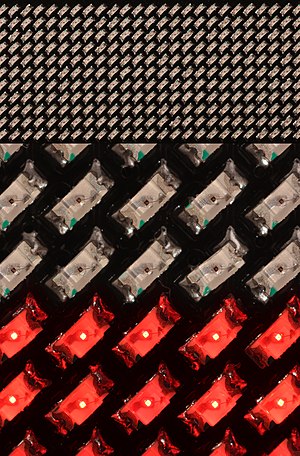From today's featured articleThe political career of John C. Breckinridge included service in the governments of Kentucky, the United States, and the Confederate States of America. Breckinridge (January 16, 1821 – May 17, 1875) was inaugurated in 1857 as James Buchanan's vice president, and remains the youngest person to ever hold the office. In 1860 he ran as the presidential candidate of a dissident group of Southern Democrats and won the electoral votes of most of the Southern states, but he finished a distant second among four candidates, losing the election to the Republican candidate, Abraham Lincoln. Most Southern states seceded, but Kentucky stayed in the Union. Previously elected to a U.S. Senate term that began in 1861, Breckenridge fled the state, joined the Confederate States Army, and was expelled from the Senate. Confederate President Jefferson Davis appointed him Secretary of War in February 1865. ( Full article...)
Recently featured:
Did you know...
|
In the news
On this day
Nikephoros Choumnos (d. 1327) · William Hall-Jones (b. 1851) · Pauline Phillips (d. 2013)
More anniversaries:
|
Today's featured picture

|
A light-emitting diode (LED) is a semiconductor light source that emits light when an electric current flows through it. When a current passes through the diode, which is formed of two different semiconductor materials, electrons are able to recombine with electron holes, releasing energy in the form of photons. This effect is called electroluminescence. The color of the light is determined by the energy required for electrons to cross the band gap of the semiconductor. White light is obtained by using multiple semiconductors or a layer of light-emitting phosphor on the semiconductor device. The earliest practical LEDs, which appeared in 1962, emitted low-intensity infrared and red light. Modern LEDs are available with high output in a range of visible, ultraviolet, and infrared wavelengths. This picture shows three different views of an 11×44 LED matrix lapel name tag display. The top image is of a little over half of the display, the center image is a close-up of the LEDs in ambient light, and the bottom image is the LEDs in their own red light. Photograph: Janke
Recently featured:
|
Other areas of Wikipedia
- Community portal – Bulletin board, projects, resources and activities covering a wide range of Wikipedia areas.
- Help desk – Ask questions about using Wikipedia.
- Local embassy – For Wikipedia-related communication in languages other than English.
- Reference desk – Serving as virtual librarians, Wikipedia volunteers tackle your questions on a wide range of subjects.
- Site news – Announcements, updates, articles and press releases on Wikipedia and the Wikimedia Foundation.
- Village pump – For discussions about Wikipedia itself, including areas for technical issues and policies.
Wikipedia's sister projects
Wikipedia is hosted by the Wikimedia Foundation, a non-profit organization that also hosts a range of other projects:
Free media repository
Wiki software development
Wikimedia project coordination
Free textbooks and manuals
Free knowledge base
Free-content news
Collection of quotations
Free-content library
Directory of species
Free learning materials and activities
Free travel guide
Dictionary and thesaurus
Wikipedia languages
From today's featured articleThe political career of John C. Breckinridge included service in the governments of Kentucky, the United States, and the Confederate States of America. Breckinridge (January 16, 1821 – May 17, 1875) was inaugurated in 1857 as James Buchanan's vice president, and remains the youngest person to ever hold the office. In 1860 he ran as the presidential candidate of a dissident group of Southern Democrats and won the electoral votes of most of the Southern states, but he finished a distant second among four candidates, losing the election to the Republican candidate, Abraham Lincoln. Most Southern states seceded, but Kentucky stayed in the Union. Previously elected to a U.S. Senate term that began in 1861, Breckenridge fled the state, joined the Confederate States Army, and was expelled from the Senate. Confederate President Jefferson Davis appointed him Secretary of War in February 1865. ( Full article...)
Recently featured:
Did you know...
|
In the news
On this day
Nikephoros Choumnos (d. 1327) · William Hall-Jones (b. 1851) · Pauline Phillips (d. 2013)
More anniversaries:
|
Today's featured picture

|
A light-emitting diode (LED) is a semiconductor light source that emits light when an electric current flows through it. When a current passes through the diode, which is formed of two different semiconductor materials, electrons are able to recombine with electron holes, releasing energy in the form of photons. This effect is called electroluminescence. The color of the light is determined by the energy required for electrons to cross the band gap of the semiconductor. White light is obtained by using multiple semiconductors or a layer of light-emitting phosphor on the semiconductor device. The earliest practical LEDs, which appeared in 1962, emitted low-intensity infrared and red light. Modern LEDs are available with high output in a range of visible, ultraviolet, and infrared wavelengths. This picture shows three different views of an 11×44 LED matrix lapel name tag display. The top image is of a little over half of the display, the center image is a close-up of the LEDs in ambient light, and the bottom image is the LEDs in their own red light. Photograph: Janke
Recently featured:
|
Other areas of Wikipedia
- Community portal – Bulletin board, projects, resources and activities covering a wide range of Wikipedia areas.
- Help desk – Ask questions about using Wikipedia.
- Local embassy – For Wikipedia-related communication in languages other than English.
- Reference desk – Serving as virtual librarians, Wikipedia volunteers tackle your questions on a wide range of subjects.
- Site news – Announcements, updates, articles and press releases on Wikipedia and the Wikimedia Foundation.
- Village pump – For discussions about Wikipedia itself, including areas for technical issues and policies.
Wikipedia's sister projects
Wikipedia is hosted by the Wikimedia Foundation, a non-profit organization that also hosts a range of other projects:
Free media repository
Wiki software development
Wikimedia project coordination
Free textbooks and manuals
Free knowledge base
Free-content news
Collection of quotations
Free-content library
Directory of species
Free learning materials and activities
Free travel guide
Dictionary and thesaurus



